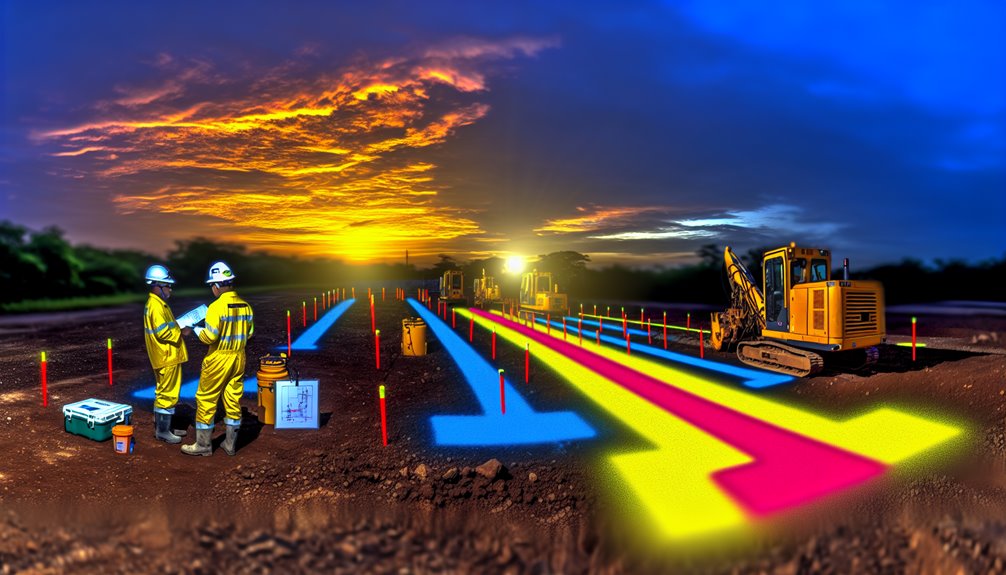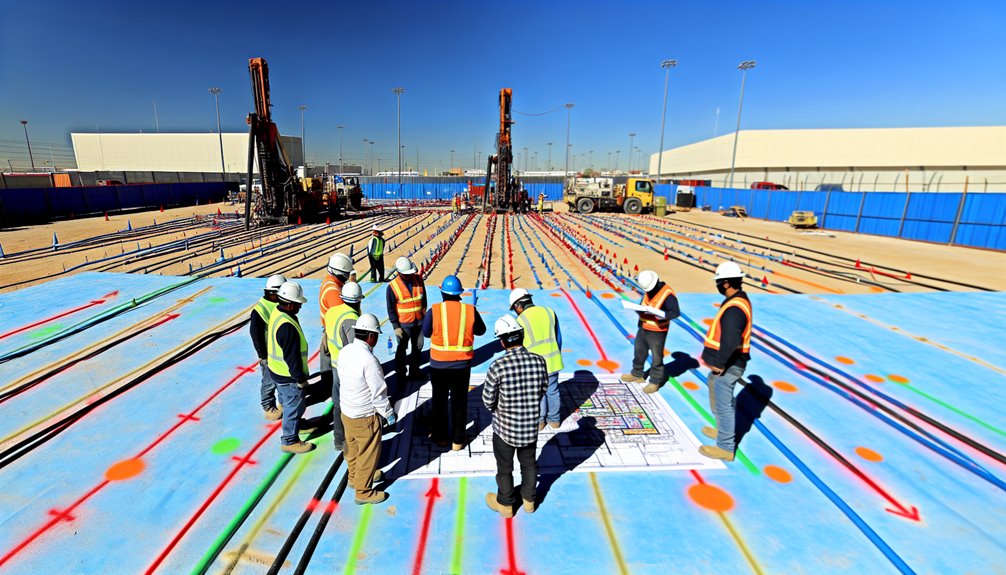Before you begin horizontal directional drilling (HDD), it's essential you conduct a thorough site survey. This involves analyzing the terrain, identifying existing utilities, and evaluating soil conditions to guarantee stability. You'll need to meticulously plan your drilling paths, taking into account the geotechnical data to avoid any subsurface surprises. Remember, the precision in these initial steps can greatly dictate the efficiency and safety of your operation. Let's explore how these preparations impact the success of your drilling project.
Conducting a Comprehensive Site Survey

Before commencing any horizontal directional drilling (HDD) project, it's important to conduct a thorough site survey. You'll need to perform a detailed site evaluation, starting with a topographic survey along the HDD alignment. This terrain analysis helps you understand the ground's undulations and potential obstacles, essential for planning the drilling path. Incorporate hydrographic surveys for significant waterways and identify all existing infrastructures like roadways, utilities, and overhead lines. Your geotechnical evaluation should extend beyond the surface, analyzing soil composition and stability to anticipate challenges like rock inclusions or loose deposits. Additionally, map out all utilities and obstacles meticulously to prevent costly damages during drilling. These preparative steps are critical in ensuring a successful, innovative HDD operation. Furthermore, understanding the hole direction is crucial for accurately orienting the drill path relative to the geographical layout.
Securing Necessary Permits and Clearances
After you've conducted a thorough site survey for your HDD project, the next step involves securing the necessary permits and clearances to guarantee legal and safe operation.
Begin by ensuring compliance through license verification, specifically acquiring a horizontal directional drilling contractor license or its equivalent, as mandated by state regulations. It's vital that your key personnel exhibit expertise, with documentation confirming their years of experience in controlling pilot hole steering and monitoring positions.
Additionally, you must develop and submit a detailed Health and Safety plan, inclusive of all safety documentation, such as Material Safety Data Sheets for drilling compounds and certified statements regarding the condition of drill rods. This meticulous approach not only adheres to legal standards but also fortifies the project's integrity against potential operational hazards.
Moreover, ensure that all personnel involved in the drilling process have undergone the necessary confined space entry training and possess valid certifications to enhance job site safety and compliance.
Planning Entry and Exit Points for Drilling

Once you've secured the necessary permits, your next step in preparing for horizontal directional drilling (HDD) is to strategically plan the entry and exit points.
Begin by integrating the findings from your geotechnical report. Analyze soil types and groundwater conditions to determine the ideal entry point considerations. You'll need to assess soil strength and stability to minimize the risk of collapse or excessive wear on drilling equipment.
For exit point strategies, evaluate the end location for accessibility and potential environmental impact.
It's vital to guarantee that the exit point allows for smooth retrieval of equipment and completion of the installation.
Setting Up the Drilling Site for Safety and Efficiency
To guarantee the safety and efficiency of your horizontal directional drilling (HDD) project, initiating a thorough site setup is essential.
Start with conducting site-specific safety assessments; identify potential hazards such as underground utilities and perform geological surveys. This hazard identification process is critical.
Your equipment selection must then align precisely with these conditions. Opt for the appropriate drill tools and supporting equipment—like mud mixing tanks and power units—based on soil analysis. Ascertain all selected tools mitigate identified risks effectively, enhancing both safety and operational efficiency.
Implement robust safety protocols, including regular walkthroughs and equipment checks. This meticulous preparation not only secures the site but also streamlines the drilling process, embodying innovation in every step.
Coordinating With Local Authorities and Utility Providers

Before initiating your horizontal directional drilling project, it's crucial to coordinate with local authorities and utility providers to guarantee compliance with regulations and prevent disruptions.
Start by obtaining the necessary permits, guaranteeing you meet stringent local guidelines. Engage with public works, environmental agencies, and other relevant departments to outline your project's scope and impact. This proactive communication supports community engagement and helps refine project timelines.
Utilize advanced mapping technologies like ground-penetrating radar to accurately locate utilities, minimizing risks of damage and disruption.
Consistent updates to all stakeholders, paired with strategic management of public disruptions, guarantee your project remains compliant and well-integrated within the community, bolstering both efficiency and public trust.
Conclusion
As you wrap up preparations for your horizontal directional drilling project, verify you've conducted a detailed site survey and secured all required permits. Strategically plan your drilling paths based on geotechnical insights to mitigate risks effectively. Set up your site prioritizing safety and operational efficiency. Finally, maintain active coordination with local authorities and utility providers to align with all regulations and avoid disruptions. These steps are essential for a successful, compliant, and efficient drilling operation.
If you're looking for more tips and insights, I invite you to visit Boring Bros at boringbro.com. You'll find a wealth of information that can help you with your project. And if you prefer a more personal touch, feel free to call us at (954) 639-6167. We're here to help you every step of the way!

